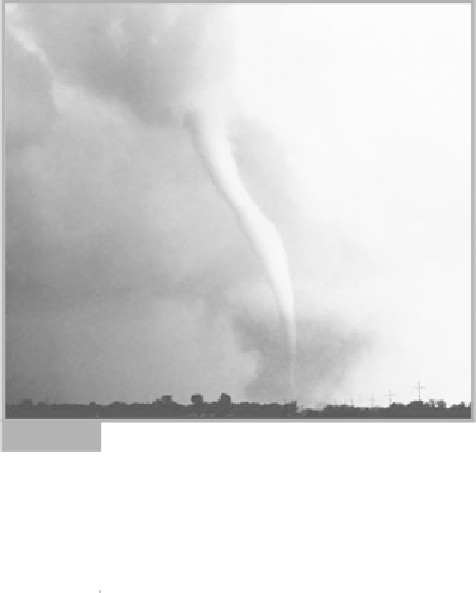Geoscience Reference
In-Depth Information
produced. The funnel has horizontal pressure and
wind profiles similar to a tropical cyclone (Figure 3.5),
except that the spatial dimensions are reduced to a few
hundred meters. In addition, tornadoes develop
greater depressed central pressure and more extreme
wind velocities at the funnel boundary. The sides of
the funnel enclose the eye of the tornado, which is
characterized by lightning and smaller, short-lived
mini-tornadoes. Air movement inside the funnel is
downward. Vertical air motion occurs close to the wall
with upward speeds of 100-200 m s
-1
. The most visible
part of a tornado, the funnel, is actually enclosed
within a slower spinning vortex. The air moving down
through the center of the funnel can kick up a curtain
of turbulent air and debris at the ground - in a process
similar to that of a hydrofoil moving over water
(Figure 4.10). This feature - termed a 'cascade' - can
also form above the ground before the main funnel
actually develops. If the cascade spreads laterally far
enough, its debris can be entrained by the outer vortex,
and if wind velocities in this outer vortex are strong
enough, the main funnel may slowly be enshrouded by
debris from the ground upwards to form an 'envelope'.
Envelopes are more characteristic of waterspouts than
tornadoes that develop over land.
Often tornado structure is more complex than a
single funnel. Air may descend through the center of
the funnel at great speed. At the surface, this air
spreads out and causes the vortex to break down. Air
spinning into the vortex undergoes a rapid change in
direction or shearing where it meets this downdraft,
leading to the formation of mini-vortices around the
main zone of rotating air. Up to half a dozen mini-
vortices may form, rotating in a counterclockwise
direction around the edge of the tornado itself. These
smaller vortices are unstable, often appearing as wispy
spirals. However, their presence can be devastating.
Mini-vortices can rotate at speeds of 20-40 m s
-1
. On
the inner side of the mini-vortex, rotation opposes that
of the main funnel leading to wind reversal or shear
over very small distances (T-V in Figure 4.11). On the
outer edge of the mini-vortex, air moves in the same
direction as that of the main funnel and enhances wind
speeds (T+V in Figure 4.11). The former condition
tears structures apart, while the latter destroys
structures that might resist lower wind speeds.
Secondary
vortex
Parent
vortex
Secondary
vortex
T - V
T + V
T - V
T + V
T, rotational speed of parent vortex
V, rotational speed of secondary vortex
Model for multiple-vortex formation in a tornado (based on
Fujita, 1971 and Grazulis, 1993).
Fig. 4.11
The highest wind velocities generated within
tornadoes have not been measured; but they can be
determined theoretically. For example, eggs or
windows cleanly pierced by a piece of debris without
shattering or a wooden pole pierced by a piece of straw
requires wind speeds in excess of 1300 km hr
-1
.
However, this wind speed exceeds the speed of sound,
a phenomenon that has not been reported during the
passage of a tornado. The maximum wind speed
measured using photogrammetry is 457 km hr
-1
. These
wind speeds can singe the skin of defeathered
chickens, move locomotives off railway tracks and shift
bridges. Because of the lack of measurement, a visual
The first tornado captured by the NSSL Doppler radar and
NSSL chase personnel. Note the defined funnel shape and
the cascade formed at the ground by the incorporation of
debris. Union City, Oklahoma, 24 May 1973. Image ID:
nssl0062, National Severe Storms Laboratory (NSSL)
Collection, NOAA Photo Library, NOAA.
Fig. 4.10










